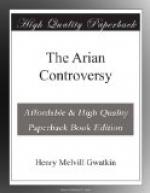[Sidenote: Rise of Anomoeans.]
We see also the rise of a new and more defiant Arian school, more in earnest than the older generation, impatient of their shuffling diplomacy and less pliant to court influences. Aetius was a man of learning and no small dialectic skill, who had passed through many troubles in his earlier life and been the disciple of several scholars, mostly of the Lucianic school, before he came to rest in a clear and simple form of Arianism. Christianity without mystery seems to have been his aim. The Anomoean leaders took their stand on the doctrine of Arius himself, and dwelt with most emphasis on its most offensive aspects. Arius had long ago laid down the absolute unlikeness of the Son to the Father, but for years past the Arianizers had prudently softened it down. Now, however, ‘unlike’ became the watchword of Aetius and Eunomius, and their followers delighted to shock all sober feeling by the harshest and profanest declarations of it. The scandalous jests of Eudoxius must have given deep offence to thousands; but the great novelty of the Anomoean doctrine was its audacious self-sufficiency. Seeing that Arius was illogical in regarding the divine nature as incomprehensible, and yet reasoning as if its relations were fully explained by human types, the Anomoeans boldly declared that it is no mystery at all. If the divine essence is simple, man can perfectly understand it. ‘Canst thou by searching find out God?’ Yes, and know him quite as well as he knows me. Such was the new school of Arianism—presumptuous and shallow, quarrelsome and heathenising, yet not without a directness and a firmness of conviction which gives it a certain dignity in spite of its wrangling and irreverence. Its conservative allies it despised for their wavering and insincerity; to its Nicene opponents it repaid hatred for hatred, and flung back with retorted scorn their denial of its right to bear the Christian name.
[Sidenote: Illustration from the state of: (1.) Jerusalem.]
We may now glance at the state of the churches at Jerusalem and Antioch during the years of rest. Jerusalem had been a resort of pilgrims since the days of Origen, and Helena’s visit shortly after the Nicene council had fully restored it to the dignity of a holy place. We still have the itinerary of a nameless pilgrim who found his way from Bordeaux to Palestine in 333. The great church, however, of the Resurrection, which Constantine built on Golgotha, was only dedicated by the council of 335. The Catecheses of Cyril are a series of sermons on the creed, delivered to the catechumens of that church in 348. If it is not a work of any great originality, it will show us all the better what was passing in the minds of men of practical and simple piety, who had no taste for the controversies of the day. All through it we see the earnest pastor who feels that his strength is needed to combat the practical immoralities of a holy city (Jerusalem was




